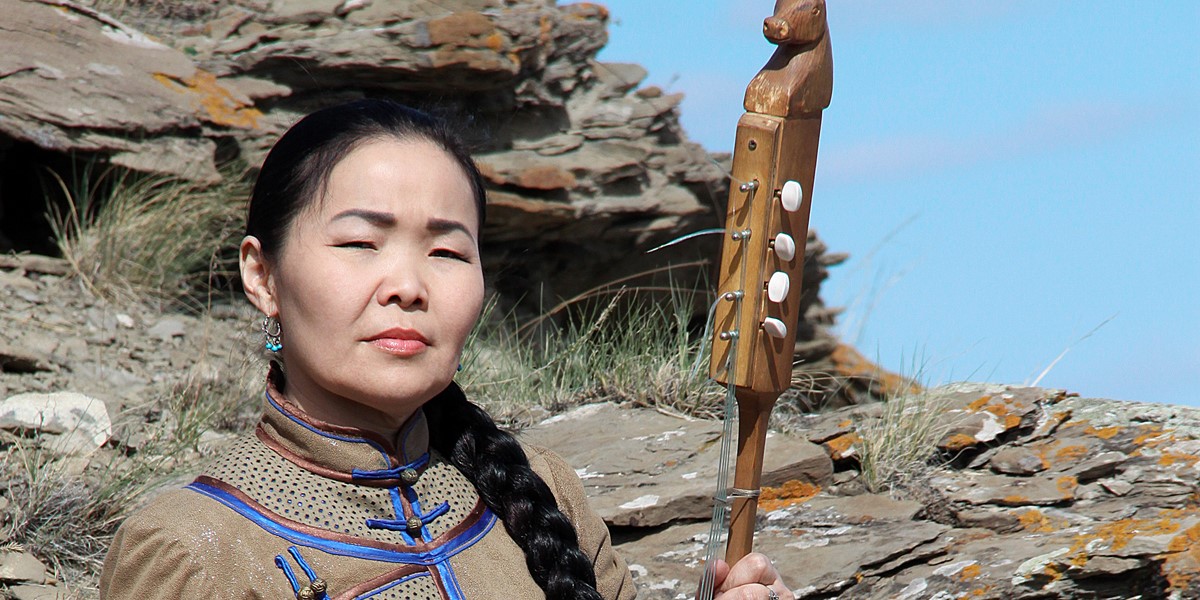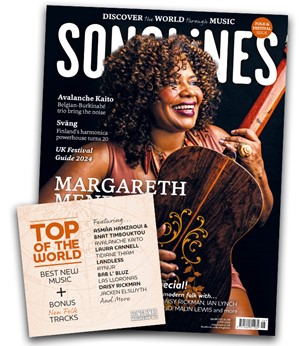Friday, March 25, 2022
“The Tyvan word byzaa refers to the mooing sound made by a calf” | Choduraa Tumat
By Carole Pegg
The beacon of Tyvan female throat-singing shines light on her rare four-stringed instrument, the byzaanchy

Raised in the Chöön-Khemchik region of western Tyva (Tuva), Choduraa Tumat experienced the traditional Tyvan soundscape in the throat-singing (khöömei, sygyt) of her brothers and the jaw harp (khomus) playing and pastoralist animal mimesis of her mother. Since then she’s developed that soundscape by challenging traditional biases against female throat-singing and igil (two-stringed fiddle) playing. In 1998, she formed the all-female throat-singing group Tyva Kyzy (Daughters of Tyva) and, in 2008, recorded the album Igil Unu, Iyem Unu (The Igil’s Voice, My Mother’s Voice) for Tyva Trader. On her latest release, Tumat focuses on the byzaanchy (four-stringed spike fiddle).
Why, I asked, was she attracted to the byzaanchy? “I first encountered it when I was about ten years old – it was played during a festival by a woman from a musical family in my village. Then I heard it again when the Tuva Ensemble played in our village club. I want to introduce this little known instrument to those interested in Tyvan music.”
The four ‘strings’ of this vertical fiddle are paired bunches of untwisted horsehair. The first and third strings are tuned to the same note, the second and fourth a fifth higher. They pass over a small bridge standing on a skin table. The long wooden neck spikes and internally crosses the wooden body, and has an open back that acts as a sound hole which is usually cylindrical, octagonal or hexagonal. Horsehairs strung on a curved bow are divided into two. The bow is permanently attached to the instrument, with one section threaded below the strings and the other above. As both the strings’ upper and lower surfaces may be played, a musician can make use of double-stopping, drones and discrete melodies. Its sounds are soft, mellow and rich in timbre.
This instrument appears in neighbouring Mongolia and Inner Mongolia under different names (dörvön chikhtei khuur, araltu khuur, bizaanz) where it mostly accompanies narrative tales. Though similar in physical structure, the Tyvan byzaanchy differs in several ways. Tumat describes its traditional context and repertoire: “It was played by men and women on family occasions and holidays. They performed mostly folk-song melodies and instrumentals.” She goes on to explain the origins of its name. “The Tyvan word byzaa refers to the mooing sound made by a calf.” Though photographs from the 1920s show the instrument’s head unadorned, contemporary players and instrument makers often carve a bull’s head on the instrument’s crown, uniquely connecting it to nomadic pastoralism. This contrasts with the male horse-herding activities expressed in the playing of the horse-headed fiddle (igil). The Tyvan instrument also differs in its playing technique – the strings are pressed from beneath, rather than from the side.
Choduraa describes how she only learned to play it after she had graduated from the Department of National Instruments in the College of Arts and East Siberian State Academy, since the byzaanchy was not part of the state musical curriculum created during the communist period. “When I began working as a Tyvan music teacher at the State Pedagogical Institute in Kyzyl, my colleague, Irben-ool Tülüsh, taught me to play on an experimental three-stringed byzaanchy, with a round wooden soundbox covered by fish skin, made by the famous master Idamchap Khomushku.”
On her new album, Tumat’s mission is to popularise the byzaanchy and its repertoire by playing instruments (including one with a rare cuboid body) from a number of makers and drawing on a range of traditional melodies and songs, including opera. But Byzaanchy also illustrates her commitment to her own creative audacity. Listen, for instance, to ‘Chashpy Khem’ (The River Chashpy), during which she interweaves byzaanchy drones with sygyt (melodic throat singing), and drones of khöömei or kargyraa (throat-singing) with byzaanchy melodies, while simultaneously delivering a folksong in traditional vocal and instrumental style.
Read the review of Byzaanchy in the Songlines Reviews Database
This article originally appeared in the March 2022 issue of Songlines magazine. Never miss an issue – subscribe today

